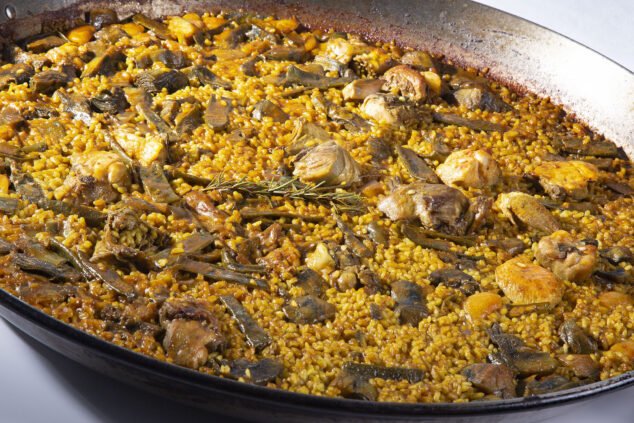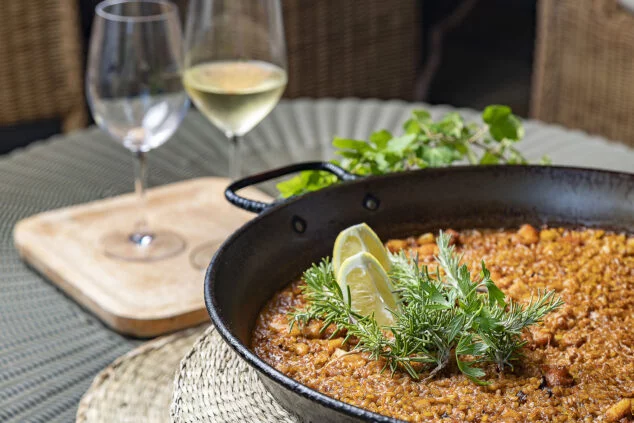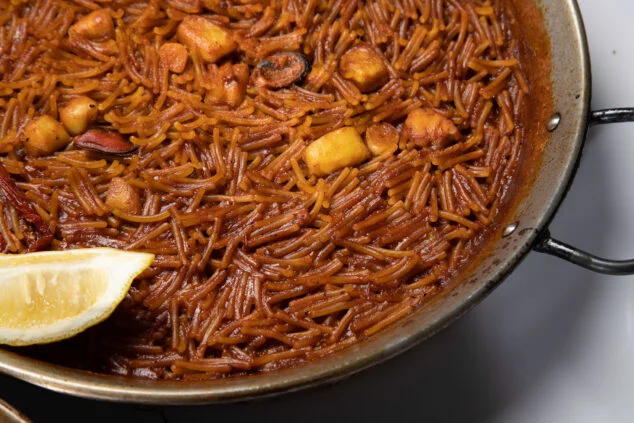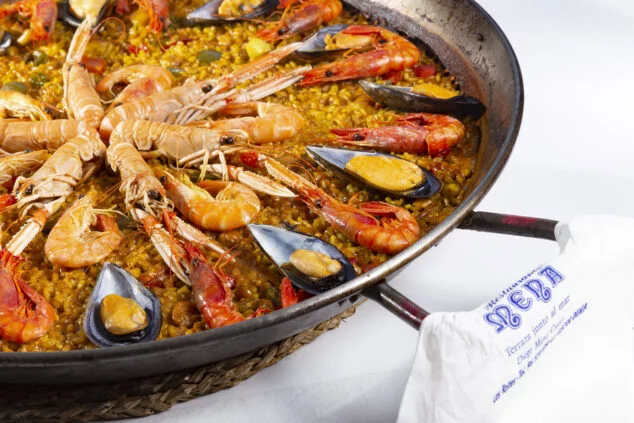We are in the Valencian Community, where rice is at the base of gastronomy. In these lines we are going to discover how our most famous rice dishes have been shaped, their recipes and where to enjoy them.
Next you have an index with all the points that we are going to deal with.
- 1.
- 2.
- 2.1.
- 3.
- 3.1.
- 3.2.
- 3.3.
- 3.4.
- 4.
History of paella
As almost always throughout history, gastronomy is totally linked to the food that people have nearby. With them as a basis, people have developed the dishes to meet their needs (for example, food with many calories to endure long hours of work or in cold places to resist low temperatures). That is to say, the gastronomy of a place is usually closely linked to the food that is produced and the way people live.
Paella emerged next to the Albufera de València, a rice plantation area, between the XNUMXth and XNUMXth centuries, with the ingredients that the peasants had at hand: rabbit, vegetables, rice and saffron. Also with snails, so abundant in the field. All cooked over low heat with a flame in which orange branches burned. In the XNUMXth century, paella was already known internationally, but not by that name yet, but it was called "Valencian rice".
This dish has undergone many variations, and we can hear the concepts Mixed paella (the meat and fish), seafood paella o vegetable paella. Strictly, these dishes are not the authentic Valencian paella, but, when they are also cooked in a paella (the container), they have tended to name them that way. Rice admits almost any ingredient, so we can find "paellas" of all kinds.
Traditional paella recipe
These are the ingredients of the authentic Valencian paella. We divide them between those that are present 100% of the time, and those that may or may not be, depending on tastes or ways of doing it.
The paella always has:
- Extra virgin olive oil
- Rice
- Saffron
- Rabbit
- Garrofo
- Jewish from horseshoe (or broad bean)
- Pollo
- Crushed tomato
- Agua y sal
On many occasions, paprika, snails, a branch of fresh rosemary, garlic, duck, artichokes, pork ribs or table (small white bean that can replace or complement the garrofó).
Steps to do it
The first thing is to make the sauce. Put oil in the paella and slowly brown the previously salted meat. When the meat is golden brown, add the bean, the garrofó and a little later the tomato. Everything continues to fry together for a while, until the tomato has diminished and the vegetables are also golden. Then the water is added, and the fire is raised to cook for a while. This is the time to add the saffron. The volume of water is usually three times that of rice, but this is something that adjusts with experience. After about 15 minutes of cooking, add the rice, which should be done for about 16 minutes, but this also depends on the power of the fire. If you are going to add rosemary, put it towards the end of the rice cooking, in the center of the paella. When you turn off the heat, it should be left to rest for 5 minutes.
Typical rice dishes of Dénia
In Dénia we know how to make a fantastic paella, but the area of Alicante and the Marina is a place closely linked to the sea and that has developed many varieties of rice with ingredients from fishing.
Plenty of rice
Literally, arròs a band In Valencian it means "rice aside, rice on the side", because it is a rice that was traditionally served separately from the fish with which it was prepared: this dish was eaten by the fishermen on the boat itself, in two batches. First they ate the fish that had been served to make the broth, and then they counted the rice separately. So explains it Wikipaella, the association that works for the recognition of authentic paellas:
"Over time, and the intelligence of the people of Dénia has a lot to blame for this, the dish was acquiring sophistication and taste. They eliminated the first delivery, leaving only the rice, to which they added noble pieces (cuttlefish, squid, monkfish, prawns, etc ... all peeled, ready to enjoy without staining your fingers). "
Therefore, eat rice a banda in Dénia refers to savoring the origins of the city. The rice a banda and the senyoret rice (translation: "arroz del señorito") are not exactly the same, although in practice, they tend to blend in.
The gentleman's rice
According to Wikipaella, the senyoret rice "It is named after the dish that the servants of wealthy households cooked for the first-born of the family. Rice could be made in a thousand ways, with infinite ingredients, always of course, to the taste of the 'gentleman of the house'." Restaurants have created a rice dish made with smell, in which the shellfish is peeled and with bits of fish without bones, which is practically the same as the arròs a band.
Arròs negre (Black rice)
It is very typical of the Alicante coastline. It is also a rice with a base of fish broth, with squid, squid, cuttlefish and prawns, but most importantly: its characteristic black color is given by the squid ink that is added towards the end of cooking.
Fideua
We "deviate" a bit from the rice, but fideuà is a dish that we often enjoy in the same way and in the same context. The traditional fideuà recipe and best known is that of Gandía. According to Gastronomic Association Fideuà de Gandia, is a dish that was born from the sailors of the Grey (The port of Gandía is separated from the city and has a different entity). The fideuà is more than a century old.
We are next door, and we treat it just as well: the fideuà is made with a well-made fish broth, preferably number 4 noodles, crayfish, prawns and chopped monkfish, as well as garlic, onion, tomato, paprika, saffron and oil made of olives. This is the traditional recipe, but there are many types of fideuàs: black fideuà, meat fideuà, vegetable fideuà, cuttlefish fideuà, fide foie (with duck foie) ...
Other rice dishes that you can find in Dénia are the honeyed rice dishes such as Mellow rice with lobster or some designed to take advantage of all that the sea gives, such as seafood paella. He too arròs amb fesols i naps (rice with beans and turnip), a typical soup rice of Valencian cuisine, or the baked rice, originally thought of as a rice made from the remains of the pot, and now turned into a dish by himself. The latter is cooked in a clay pot.
Where to eat rice in Dénia
You want to know Paella restaurants in Dénia? Here we leave you a very easy to consult list, with names, addresses and contact.
- L'anfora, in Explanada Cervantes 9. Telephone 96 578 61 19.
- Hotel Los Angeles, in the Playa de las Marinas km. 4. Telephone 96 578 04 58.
- Rice is in the Marina de Denia, Dársena de Babor s / n, Building D local 5. Telephone 96 578 97 71.
- restaurant Balandros It is in the Nautical Club of Dénia - Carretera Dénia-Xàbia Y / N, they attend you at 96 629 03 13.
- El Comercio is at Marqués de Campo 17, and on the phone 965 78 56 91.
- La Cuina de Pepa: Plaza Mariana Pineda 7, phones 636 923 127 or 670 979 775.
- Tasca Eulalia: Marqués de Campo 39, telephone 965 78 64 79.
- restaurant Isa: Playa de l'Almadrava 1, telephone 966474369.
- restaurant Mena: End of Les Rotes, phone 96 578 09 43.
- Casa Miguel Juan: Loreto street, 39. Telephone 628 94 82 32.
- Restaurant Noguera It is in the carrer Llac Major, 3 (Carretera de las Marinas, km 6), telephone 96 647 41 07.
- restaurant Voramar, in Carretera de Las Marinas, km 3. Telephone 965787170.
Here we also leave you references if you want Paella to take away, at home or paella on request in Dénia. And if you have a restaurant, and you want to appear on this list, contact david@avantcem.com










